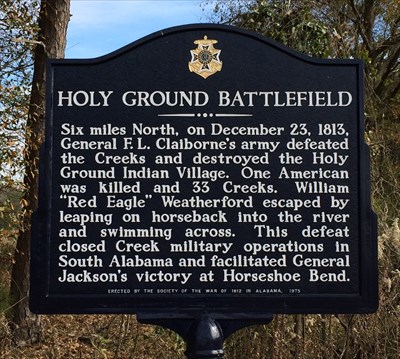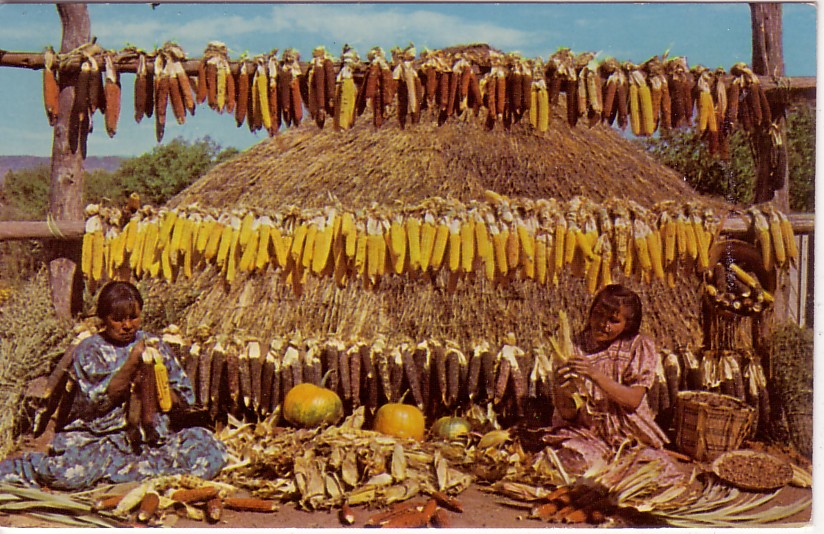The Alabama POW Camps Are Not Very Well Known
The Alabama POW camps were some of the most active in the country, and young people today have no idea they even existed.
Not only did they exist, there were four major prisons and 20 smaller satellite prisons, which were very important to the state overall.
In fact, in some of the areas where they were located, because of the War that was going on, they were extremely important to the economy.
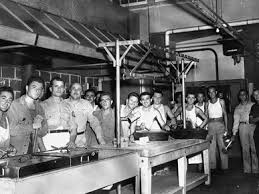 German POW Camps Opened in Opelika Alabama
German POW Camps Opened in Opelika AlabamaNot only would the military be involved in running them, civilians also helped to run them.
Their very interesting history and culture are preserved in two sites to this day in the state of Alabama.
They include the Aliceville Museum and Cultural Center in Aliceville, and the Museum of East Alabama in Opelika.
The History of the Alabama POW Camps
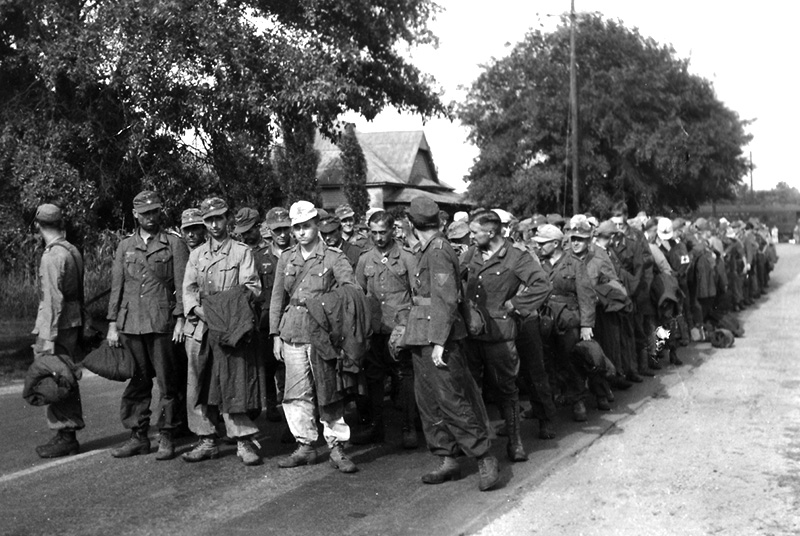 Pictures From The Alabama POW Camps
Pictures From The Alabama POW CampsThe Alabama POW Camps have a very interesting history, and all of it centers on World War II.
During the height of World War II in 1943, the Allied forces had just defeated a vast number of enemy soldiers primarily from two countries.
These countries were two of our biggest enemies, Germany and Italy, in the fighting that was ongoing in North Africa.
These victories were so massive by the Allied forces that over a quarter of a million enemy troops were captured.
In order to house and secure these enemy soldiers, prisons were set up in most every state in the country.
This set the stage for the Alabama POW camps, as this state was no different than the rest, and would eventually become home for over 16,000 enemy soldiers.
At first Alabama only had two of these prisons, but as the war progressed, more would be added.
They were built by the Army Corps of Engineers, and the first two were built in the winter of 1942-43.
They were extremely particular where these camps were to be built, as they had to be located at existing military bases or in very rural communities.
The Army Corps of Engineers did not want them anywhere near a mid to large US city, so they spent over a year surveying for the correct locations.
The first two sites that were selected to be the locations for the Alabama POW Camps were the towns of Aliceville and Opelika.
Both were very small rural towns at the time, and were located in Pickens and Lee County.
The prison located in Aliceville was designed to be the largest in the state, and it was built to hold over 6,000 prisoners of war.
The prison located in Opelika was about one-half of the size, and it was built to house roughly 3,000 prisoners
However, once the Army Corps of Engineers started to build these two camps, a third was announced.
It would also be home for about 3,000 prisoners, and would be located in an active military base, Fort McClellan.
However, they did not stop there as in early 1944 a fourth site was added, and it was also another active military base, Fort Rucker.
By the year 1945, before this horrible war would come to an end, the Army Corps of Engineers added 20 satellite camps to the four that already existed.
When all capacities were combined, the state of Alabama would house more than 16,000 prisoners of war.
What the Alabama POW Camps Were Like
 The Camp Opelika Historic Marker In Opelika Alabama
The Camp Opelika Historic Marker In Opelika AlabamaThe Alabama POW Camps were set up and ran under the 1929 Geneva Convention, and unlike several countries, the United States played by the rules.
Two of the most fundamental rules that were to be followed was that the prisoners had to eat right, and have recreational activities.
It is a well-documented historical fact that the conditions were so good at these camps, that several of the local residents resented their conditions.
The reason for this was simple; they were forced to ration food and other supplies because of the war, while these prisoners lived in relative comfort.
In fact, unlike most prisoner-of-war conditions around the world, very few of these Germans or Italian solders tried to escape because of these “good conditions”.
In fact, as many German prisoners of war would later recount, the only real dangers they faced was their own internal “civil wars” that were going on.
Like the rest of the world at the time, the German prisoners had either very strong Nazi loyalism, or were just the opposite, and were anti-Nazi.
However, the Alabama POW Camps guard’s did not have to endure much of this, as the Army separated these two factions and moved them out of the state.
What they did endure, was the social and economic history that theses prisoners brought to the area, and to this day, some of the prisoners or their families are still in contact with their civilian “friends”.
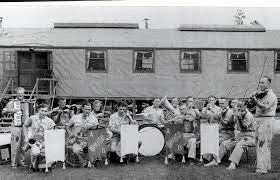 POW Band
POW BandThe daily life of these prisoners was about as far from suffering as there was for such conditions.
In fact, most of their time consisted of either work or leisure activities, and most all of them worked in local farms or businesses.
Because the war effort the United States was under during this brutal war, the state had very few farm workers to work the local farms.
They had either moved to large cities to help the with war effort, or they had joined the military.
However, the Alabama POW Camps made up for this shortage, as these prisoners helped with this labor.
This not only included helping to plant the States most important crops like cotton and peanuts, it also included harvesting them.
The army had extremely strict regulations against fraternizing with the prisoners, but the America spirit is very hard to control.
Several local residents found these prisoners very likable, and while we were at war with them, found them to be human just like us.
This resulted in several friendships that last to this day, as these prisoners found the Americans to be the best people they ever met, according to several historians.
As far as the recreational activities went, these prisoners were allowed to do something they grew up doing; play soccer.
In fact, they were so good at soccer that they formed local teams and this actively also became part of the guard’s lives.
It became so popular that teams in Camp Aliceville and Fort McClellan were even monitored by the local newspaper, where they published the games results.
These camps were also allowed to participate in their own newspapers, where they also made a lot of local and regional American friends.
They would write essays and articles about their life, and how much they actually enjoyed the treatment they were receiving.
 German POW Camp in Opelika Alabama
German POW Camp in Opelika AlabamaThese articles and essays were read by the locals and the guards, but this “leisure time” of soccer and articles did not end here.
Some of these prisoners also were allowed to give musical performances, which were made possible by private donations of instruments.
Some of them were so good at this, that they actually formed orchestras that would include professional musicians.
These camps also established colleges, where they were allowed to study basics such as math, science, vocational skills, as well as preparatory classes.
These classes included medical, law, and engineering studies.
However, after the Germans lost the war and the world found out about the horrible crimes they committed, these classes stopped.
New classes were introduced to help re-educate prisoners held at the Alabama POW camps, and they included American history, society, and the political structure in the United States.
The satellite camps that developed were the result of the labor shortage the country was experiencing during the war, as it needed these prison laborers.
While there were some Italians in these camps, the vast majority of the prisoners were Germans.
However, it was found that during the war, there were several citizens of other countries that were forced into the German army and would later become POW’s.
This included men from Belgium, Latvia, Poland, North African, and even the former Soviet Union.
Shortly after the war, all of the Alabama POW Camps were closed and the prisoners were sent back to their respective countries.
However, during the postwar construction period, something amazing happened that to this day stands as a testament to the goodness of the United States.
Several German prisoners called on the “friends and hosts” they had met while in captivity, and the American people responded like we always do.
We sent food, clothing, and other necessities to help them, which resulted in numerous friendships that stand to this day.
These and other memories of the Alabama POW camps can be found again in the Aliceville Museum and Cultural Center, and the Museum of East Alabama in Opelika.
References
http://www.encyclopediaofalabama.org/article/h-1418
The Military History Of Alabama

Alabama Gift Store
Numerous Items for You and Your Family to Enjoy
See it here at the Gift Store
Copyright 2019-2023 Alabamabackroads.com
All Rights Reserved
